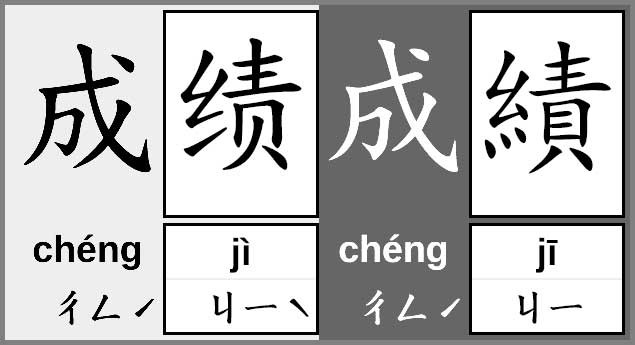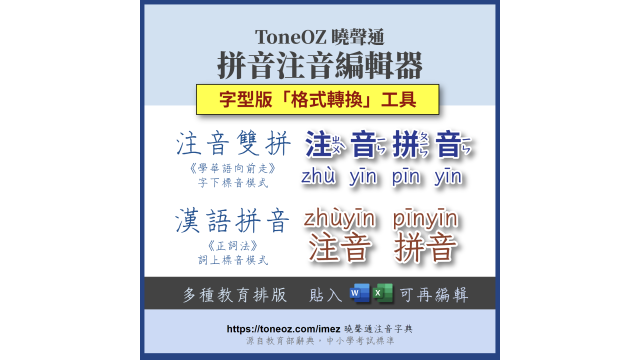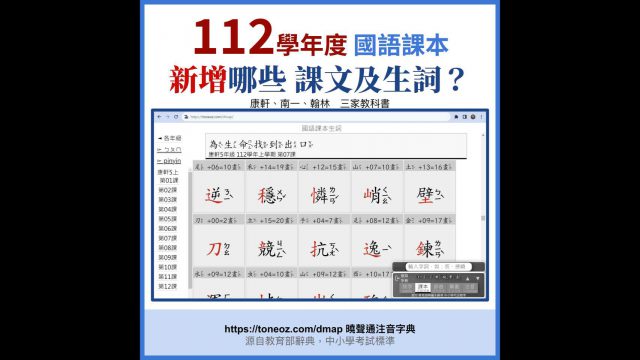Given 100 questions, a Pinyin student answered all correctly, but a Zhuyin teacher might only give him a score 97% . Why ?
Mainland Common Tongue (Pǔtōnghuà 普通话) and Taiwan National Language (Guóyǔ 国语)
By “character” : 13~38% Diff
There were many essays related to the topic “Pronunciation differences in Chinese Mandarin between Mainland and Taiwan”. e.g. :
“Comparison of the Chinese pronunciations between Mainland China and Taiwan” (海峡两岸字音比较) by Qingmei Li (李青梅), 1992
“A Study of the Distinction of Pronunciation Standards between Taiwan and Mainland China” (两岸语音规范标准之差异探悉) by Jihong Nan (南基弘), 2008
Most of them are based on “Diff by character” : The 3500 high frequency words specified in “List of Commonly Used Characters in Modern Chinese” (现代汉语通用字表, 1988).
Experts check the differences character by character. While a mismatched pronunciation was found, essays usually provide several example “words / vocabularies” with that character.
E.g.: 绩/绩 (means “achievement”) is pronounced differently. In Mainland it is tone 4 (jì ㄐㄧ\), while in Taiwan it is tone 1 (jī ㄐㄧ). As an example, the vocabulary “成绩/成绩” :

In this way, a final diff percentage was calculated, based on characters:

“13%~38%” is a large difference. It makes people feel like a student could only get a reduced score of 62%, with his 100% corret study from the other side? A little bit more than realistic.
By “vocabularies” : 3% Diff
In stead of only compare the 3500 characters, ToneOZ tried a new way : To compare all 170,000+ words / vocabularies in the dictionary. The Chinese characters are pronounced differently after they are combined into words / vocabularies, this should give us some data from a different point of view.
By “vocabularies”, there are 513 characters from around 6K words/vocabularies have been identified with different pronunciation between the Common Tongue and the National Language. It is based on a programmatically comparison and then a manual review for around 170K words/vocabularies from several word banks :
CEDICT (the largest open source Mandarin-English Dictionary)
National Language Mandarin official dictionaries “Applied Modern version Jian-Bian-Ben” (国语辞典简编本) and “Literature version Zhong-Bian-Ben” (国语辞典重编本) by the Taiwan Ministry of Education)
“Jeiba” Chinese text segmentation database.
The diff rate is 3.88% : In all 170,580 words, there are 6,623 words are pronounced differently.
We also use word banks to filter percentages from “high frequency words” only. In Australia, there are 2 common Chinese certifications:
Chinese Proficiency Test, Hanyu Shuiping Kaoshi
(汉语水平考试 , HSK)
Test of Chinese as a Foreign Language
(华语文能力测验, TOCFL)
They are both designed for non native Chinese speakers to learn general conversations. As results:

The results filtered by HSK and TOCFL are all close to 3%, which gives us more confidence in this number. And if we filter from basic levels only, the percentage becomes around 1%(For basic conversation ability, HSK level 3 or TOCFL level 4 is required).
In conclusion : There are pronunciation differences in Chinese Mandarin between Mainland and Taiwan, but not too much, only about 3% words are pronounced differently. In general conversation the difference rate could become 1% only. You don’t have to worry too much about these differences if you are learning Chinese.
Toneoz.com/data provides a list for all the Chinese words with pronunciation differences, and it can also check pronunciation differences from a whole Chinese sentence.
Read More

正词双拼、汉语拼音加汉字,Word文字排版可编辑
用ToneOZ的「格式转换」功能即可在Office Word中打出注音拼音双拼、或汉语拼音加汉字。可选择词标音或字标音,支援《正词法》及《人教版语文》等多种排版方式。贴入Word后,文字可再编辑。 字体版编辑器网址 https://toneoz.com/ime 使用方法 在晓声通ToneOZ字体版打字。请选「仅汉字」系列字体。下方「格式转换」工具,选:「a. 字pīn」及「1. 词上标音」或「2.词下标音」按下方「汇出格式转换」按钮。ToneOZ会显示「已汇出剪贴板!请贴到其他App」打开Office Word,贴上即可。请记得先到「字型下载区」找到适当字体安装 如何调整排版 …
注音双拼、汉语拼音加汉字,Word文字排版可编辑
可编辑式拼音编辑功能「格式转换」 用ToneOZ的「格式转换」功能即可在Office Word中打出注音拼音双拼、或汉语拼音加汉字。可选择词标音或字标音,支援《正词法》及《学华语向前走》等多种排版方式。贴入Word后,文字可再编辑。 「双拼」「注音」「拼音」多音字型 晓声通也提供免费的TTF多音字型下载,请参考「多音字型下载」区 多音字编辑器网址 https://toneoz.com/imez 使用方法 在晓声通ToneOZ字型版打字。 注音双拼时,请选「ㄅ」注音系列字型。即注音符号在右边的字型,再搭配本页介绍的格式转换便可以把汉语拼音加在上面 …
112学年度国语课本,有哪些新增修订?
112学年度新学期、新课本、新课文、重点更新有哪些?三家出版商准备了许多新课文与新生字词,习题及考试题目当然也都搭配好了。新课文最多的是108课纲应届五年级同学,其他各年级也多少有修改。 以下列表把各出版商的修改处都分类整理好了,方便老师们备课。如需搭配免费的字典工具,请到搜寻引擎找关键字「晓声通注音字典」即可,所有新课文生字词都已更新。 晓声通注音字典能以注音字型显示教育部辞典全文内容,并且支援「词语广度扩展」,点击辞典内文中不熟悉的词,瞬间连续查询带出更详细的词与解释。 ++++ 翰林112上学期 ++++ == 翰林3上 == 变动课文 …
中文如何做出「部首变色」效果?使用免费的课本生词「晓声通部首字型」。
国语课本的生字词普遍使用「部首变色」的特殊字型,来帮助学生了解生字的部首及部件位置。透过视觉上的强调,在自然而然的阅读中熟悉汉字的结构和规则,提高认字阅读能力。 使用免费的「澳声通部首字型」便可轻松做出「部首变色」的字型效果。(字型下载请到https://toneoz.com/blog/download-fonts/) 这是「晓声通 全文注音 国语辞典」提供的免费字型,经过特殊编辑,只会显示符合教育部标准的部首部件(即「康熙字典214部首」),目前支援六千多字,涵盖教育部简编本国语词典,及台湾三家出版社历年国语课本生词。支援注音与拼音,分别与澳声通注音及拼音繁体字型相对应,同样提供免费商用授权,老师们可任意使用不用额外付费。 使用的方法是:在Office文件中复制两个内容一模一样的文字方块,位置完全重叠。下方的文字方块使用「澳声通库楷」楷体字型,上方的文字方块用部首字型并设定成红色。如此便可产生出「只有部首变色」的字体。 澳声通全系列字型都支援多音字,注音拼音两种版本任选。利用线上选音器 https://toneoz.com/imez 可以自动或手动选破音多音字,也可将整编文章的注音关闭(全选文章后,切换上方工具列的「注音/拼音」开关即可)。注音资讯会内嵌在文字中,可直接复制到Office中使用,选好的多音破音会一起跟着复制。 请至「晓声通字型专页」下载免费字型档案 …
教育注音字典「晓声通」- 为大屏、平板教学设计的「广度拓展」国语辞典
晓声通字典源自教育部《一字多音审定表》标准辞典,使用中小学考试标准字音及字词解释。网址:https://toneoz.com/dmap 介绍一些容易上手又好玩的国语字典功能,如「扫描成语造词」「同部首字探索」「课本生词连动」…透过特别设计的使用介面,让老师们在大屏跟平板教学时有效果又有效率。 Web4.0智慧物联网时代的字典 Web 4.0智慧物联网时代,如果只是为了查一个字或查一个词的解释,大部分人会找搜寻引擎或直接问手机的语音助理。字不会写可以直接语音输入,字不会唸可以手写输入,万一不会唸也不会写,还可以直接拍照影像搜寻。 然而一本好的字典,在教育场合有个灵魂功能:「拓展词汇」。 词汇的「广度拓展」:无法取代的查字典乐趣 举例来说: 语言素养的形成,除了「直向」查询字义的深度探索,也需要字词间「横向」连结的广度拓展。透过查字典的过程来发现更多字词左右邻居之间的关联,再连结到生活中的经验,这样的乐趣能提供动机,激发主动学习的兴趣。传统纸本字典在翻找的时候,读者自然而然会接触到许多前一页后一页上额外的字汇,这些都是查询生字时的无形收获。 晓声通字典:教育部标准资料、瞬间呈现横向关联、支援多音注音字型 …
